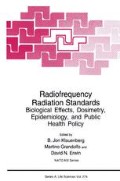Abstract
A review of the history of setting standards for safe exposure to electromagnetic energy shows a strong reliance on science and the associated finding of thresholds for effects and hazards. The reliance on science has been attacked by a number of journalists, historians and social scientists over the last 15 years resulting in calls for “prudent avoidance” and the abandonment of reliance on established science. Accompanying this trend has been much misinformation and miseducation by the media leading to electrophobia. There are strong indications, however, that society is beginning to realize that emergent technologies and economic well-being are dependent on rational science-based standards. Thus, in the development of new standards, the need for two tiers of exposure limits in response to public concerns is justified only in an uncontrolled environment and only in those areas of the spectrum where a significant uncertainty exists about the scientific database. This resolves down to environmental exposures only, the frequency range around the resonance of the human body, and for long-term exposures only. Whether this two-tier philosophy should be extended to the extremely low frequency (ELF) range is debatable.
Access this chapter
Tax calculation will be finalised at checkout
Purchases are for personal use only
Preview
Unable to display preview. Download preview PDF.
References
Public Law 90-602, Radiation Control for Health and Safety Act of 1968, Approved by the U.S. Congress (October 18, 1968).
R.C. Petersen, Radio frequency/microwave protection guides, Health Physics, 61:59–67 (1991).
IEEE, IEEE Standard for Safety Levels with Respect to Human Exposure to Electromagnetic Fields, 3 kHz to 300 GHz, IEEE C95.1-1991, Institute of Electrical and Electronics Engineers, New York, 1992. Approved by ANSI (1992).
I. Nair, M.G. Morgan, and H.K. Florig, Biological Effects of Power-Frequency Electric and Magnetic Fields, Report OTA-BP-E-53, U.S. Government Printing Office, Washington, D.C. (May 1989).
J.M. Osepchuk, The need for science-based standards in EMF policy, in: “Proc. of the First World Congress on Electromagnetics in Biology and Medicine,” Orlando, FL (June 1992).
P. Brodeur. “The Zapping of America,” New York: William Morrow (1978).
N.H. Steneck. “The Microwave Debate,” Cambridge, MA: MIT Press, 234–235 (1984).
P.M. Sandman, Risk communications: facing public outrage, EPA Journal, 21-22, (November 1987).
Q. Balzano, J.A. Bergeron, J.M. Osepchuk, and R.C. Petersen, On the need for a full-spectrum EMF policy: reliance on science-based standards for the safe use of electromagnetic energy, Forum (in press, 1993).
J.M. Osepchuk, Some misconceptions about electromagnetic fields and their effects and hazards, in: “Biological Effects and Medical Applications of Electromagnetic Energy,” O.P. Gandhi, ed., Englewood Cliffs, New Jersey: Prentice Hall, ch. 20 (1990).
K.R. Foster and W.F. Pickard, The risks of risk research, Nature, 330:531–532 (1987).
E.R. Adair, Currents of death: rectified, Paper commissioned by IEEE-COMAR (1990).
M. Yost. “Non-Ionizing Radiation Questions and Answers,” San Francisco: San Francisco Press (1993). (Revision of 1988 version.)
D.L. Ray. “Trashing the Planet,” New York: Regnery Gateway (1990).
R. Bailey. “Eco-Scam.,” New York: St. Martins (1993).
M. Pumento. “Science Under Siege,” New York: Morrow (1993).
M.W. Lewis. “Green Delusions.” Durham, North Carolina: Duke University Press (1992).
L.L. Schloesser, Green guidelines, Reasons, 33-34 (April 1993).
J.M. Osepchuk and R.C. Petersen, The role in emerging technologies played by standards for exposure to electromagnetic energy, IEC (1993, in press.).
Editorial, Jury should be commended, Wilson County Citizen. Fredonia, Kansas (January 25, 1993.
F. Burgos, Cellular radiation safety is a hot issue in Wilmette, Chicago Sun-Times (March 11, 1993).
V.A. Vanko, V.M. Lopukhin, and V.L. Sarvin, Satellite solar power systems, Sov. Phys. Usp., 20(12): 989–1001 (December 1977).
R.V. Pound, Radiant heat for energy conservation, Science, 208:494–495, May 2, 1980.
Massachusetts Department of Public Health, “105 CMR 122.000, Fixed Facilities Which Generate Electromagnetic Fields in the Frequency Range of 300 kHZ to 100 GHz and Microwave Ovens,” (1983).
NCRP, “Biological Effects and Exposure Criteria for Radio Frequency Electromagnetic Fields,” National Council on Radiation Protection and Measurements, Bethesda, Maryland, NCRP Report No. 86 (1986).
Author information
Authors and Affiliations
Editor information
Editors and Affiliations
Rights and permissions
Copyright information
© 1995 Springer Science+Business Media New York
About this chapter
Cite this chapter
Osepchuk, J.M. (1995). Impact of Public Concerns about Low-Level Electromagnetic Fields (EMF) on Interpretation of EMF/Radiofrequency (RFR) Database. In: Klauenberg, B.J., Grandolfo, M., Erwin, D.N. (eds) Radiofrequency Radiation Standards. NATO ASI Series, vol 274. Springer, Boston, MA. https://doi.org/10.1007/978-1-4899-0945-9_36
Download citation
DOI: https://doi.org/10.1007/978-1-4899-0945-9_36
Publisher Name: Springer, Boston, MA
Print ISBN: 978-1-4899-0947-3
Online ISBN: 978-1-4899-0945-9
eBook Packages: Springer Book Archive

